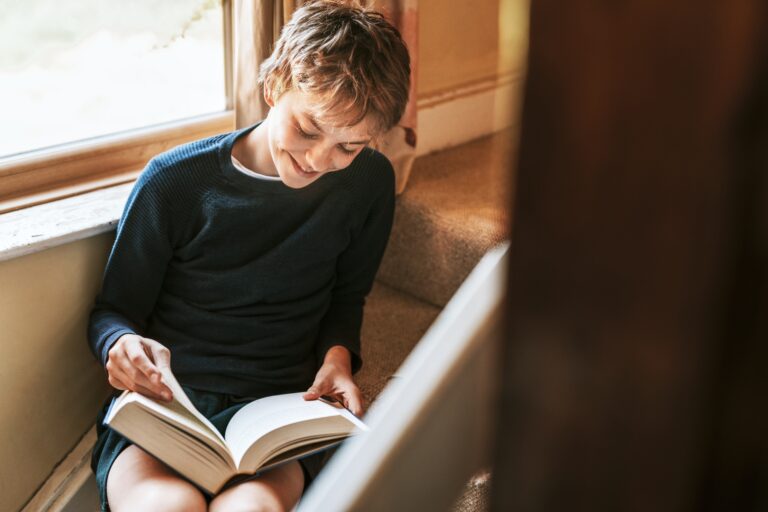How to Use the Library with Kids (Even If It’s Been Years)
🎧 Prefer to listen instead?
This post is also available as a podcast episode.
If your last library trip ended in chaos—or you’ve been avoiding it altogether—you’re not alone.
Maybe your kids melted down before you even made it past the first shelf. Maybe you left with a mountain of books no one ever read. Or maybe your library card is still buried at the bottom of a diaper bag you haven’t used in three years.
Whatever your situation, this post is here to help.
Because while the library sounds great in theory (free books! cozy corners! lifelong readers!), the reality with kids often looks a lot messier. And if your visits haven’t gone the way you hoped, that doesn’t mean the library isn’t for your family.
It just means there’s a better way to approach it—one that actually works for your kids, your schedule, and your sanity.
If you joined me for the Reset & Read Workshop, this post is the perfect follow-up. In that workshop, we talked about building reading rhythms that fit real life. And one of the best ways to keep those rhythms going? Keeping books fresh, fun, and easy to access—without buying a whole new bookshelf every season.
That’s where your library comes in.
When the library fits into your rhythm, it takes the pressure off. You’re not scrambling to find something new when your kid says they’re bored.
You’ve got books for the backseat, for bedtime, and for those in-between moments when you need a quick connection or a quiet reset. And because the books rotate, reading stays fresh—without you having to constantly spend money to keep it that way.
So whether your goal is to spend less, keep your kids excited about reading, or just stop hearing “we’ve read everything already”—learning how to make library visits work for your family is worth it.
Before we can make the most of our library visits, it helps to understand why they tend to go sideways in the first place.
Why Library Visits with Kids Feel So Hard
On paper, a library visit sounds simple: head in, grab some books, head out. But if you’ve ever actually taken kids to the library, you know it rarely plays out that way.
It’s more like this: one child beelines to the shelves and starts pulling down books faster than you can keep up. Another heads off in the opposite direction—or digs in their heels because they’d rather be anywhere but there. You’re trying to wrangle them both, answer a hundred questions, and somehow make thoughtful book choices in the middle of the chaos.
And all the while, you can feel the eyes on you—the quiet pressure to keep your kids calm, respectful, and definitely not climbing under the table.
It’s a lot.
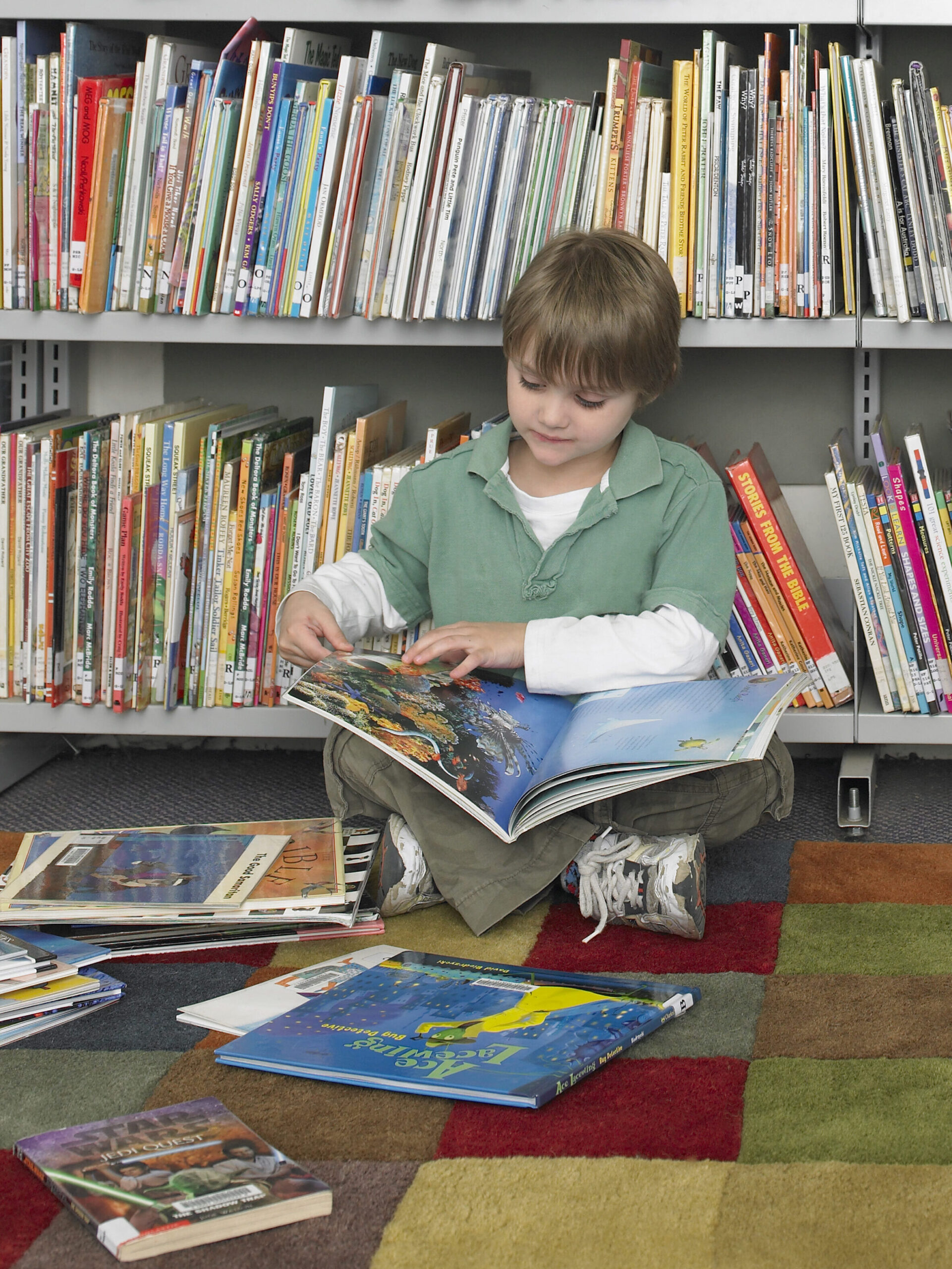
Some visits feel rushed from the start—you’re squeezing it in between errands or racing the clock to get home before dinner. Other times, the stress hits the second you walk in. The kids are loud, distracted, or flat-out resistant. And if you’re trying to engage a reluctant or struggling reader? It can feel like dragging them into a space they’d rather avoid.
Because unlike the park or the movies, the library doesn’t always feel like fun. It asks kids to do things that can feel hard—sit still, be quiet, make decisions, and delay gratification. And if reading already feels tricky, the whole visit can start to feel more like school than a good time.
And without a plan, it’s easy for the whole visit to unravel—especially if your child doesn’t know how to pick books they’ll actually enjoy, or you’re stuck second-guessing every choice.
I’ve been there.
The first time I took both of my boys to the library, I had high hopes. But within minutes, I was frazzled. Hunter darted one way, JD dragged his feet in the other. He didn’t really want to be there, and Hunter started melting down before we even made it to checkout. And the whole time, I couldn’t shake the feeling that I was that mom with the noisy, obnoxious kids.
We left with maybe five books for Hunter, and one (reluctantly chosen) book for JD.
I was disappointed. Frustrated. Overwhelmed. And honestly? I didn’t go back for a while.
For the next few visits, I only had it in me to bring one kid at a time—because two felt like too much. And even then, each visit came with its own challenges. Hunter grabbed anything that looked fun, with no real plan, and I was scrambling behind him to put books back on the shelves while trying to rein him in. JD needed a little convincing just to come along—and even more help finding books he’d actually read.
I learned a lot from those early trips. Mostly, that library visits don’t magically go well just because the library is a magical place. Because not all kids see it that way.
They go well when you have a plan that fits your kids—and your energy level.
And that starts before you ever walk out the door.
How to Prep Before You Go
These days, before we even grab our library tote, we do a quick check-in.
Nothing fancy—just a few small steps to set the tone. And once we’re surrounded by shelves, shiny covers, and kids pulling books like it’s a race? That prep makes a big difference.
How to Plan Your Library Visit as a Family
Before we head out, I’ll ask a few questions to help guide their choices once we get there—things like:
- “What kind of books are you hoping to find today?”
- “We’re almost done, our family read aloud, can you help keep an eye out for the next one?”
- “How do you figure out if a book is a good fit for you?”
- “What are three things you’d like to look for?”
- “Is it a good idea to get different types of books?”
Sometimes they’re in the mood for silly books, or animal stories, or comics. Other times they want something I’ll read to them—or something they can try on their own.
If I know we’ve got a busy couple of weeks ahead, I’ll gently encourage them to grab more books they can read independently. That way, we’ve got options ready even if my schedule gets tight.
It doesn’t have to be super specific—just enough direction so we’re not walking in and grabbing at random.
Setting Behavior Expectations Before Your Library Visit
Instead of rattling off the usual “no running, quiet voices, no climbing on tables” list (yes, I’ve actually had to say that one), I try to make it more of a conversation.
I’ll ask:
- “What do we need to remember while we’re there?”
- “What does good library behavior look like?”
- “What kinds of behavior would end our visit?”
- “When mommy says it’s time to go, what do we need to do?”
It’s less of a lecture that way—and they’re way more likely to listen when they’ve helped talk through the plan.
This is also when I’ll give them a heads-up on what kind of visit this will be. Do we need to be quick and focused? Or will we have time to linger and maybe read a book or two while we’re there?

Choosing a Realistic Book Limit for Your Family
This one’s big.
Yes—we’ve hit the 50-book limit before. No—we didn’t read them all.
Now, we usually pick a number ahead of time—somewhere between 20 and 40 depending on what the week looks like. That way, they’re not melting down at checkout because we can’t take home every single book they touched.
How to Use Book Holds to Simplify Library Visits
If I know we’re headed in for a quick trip or there’s a good chance we’ll be low on energy, I’ll hop onto the library website and request a few books ahead of time.
It takes the pressure off everyone. Even if the visit gets cut short or no one’s in the mood to browse, we’ll still walk out with something they’re excited to read.
This prep doesn’t take long, but it completely changes how things go once we walk in.
What to Expect (and How to Adjust) at the Library with Kids
Even with a solid plan, no two visits look exactly the same—because no two kids show up exactly the same way every time.
Some days are smooth. Some? Not so much.
And that’s okay.
Navigating the Library with Kids of Different Ages & Levels
Hunter’s still figuring out how to pick books he can actually read (instead of just the ones with cool covers). So I stay close—helping him slow down, flip through a few pages, and decide if it’s something he’ll enjoy or get frustrated with.
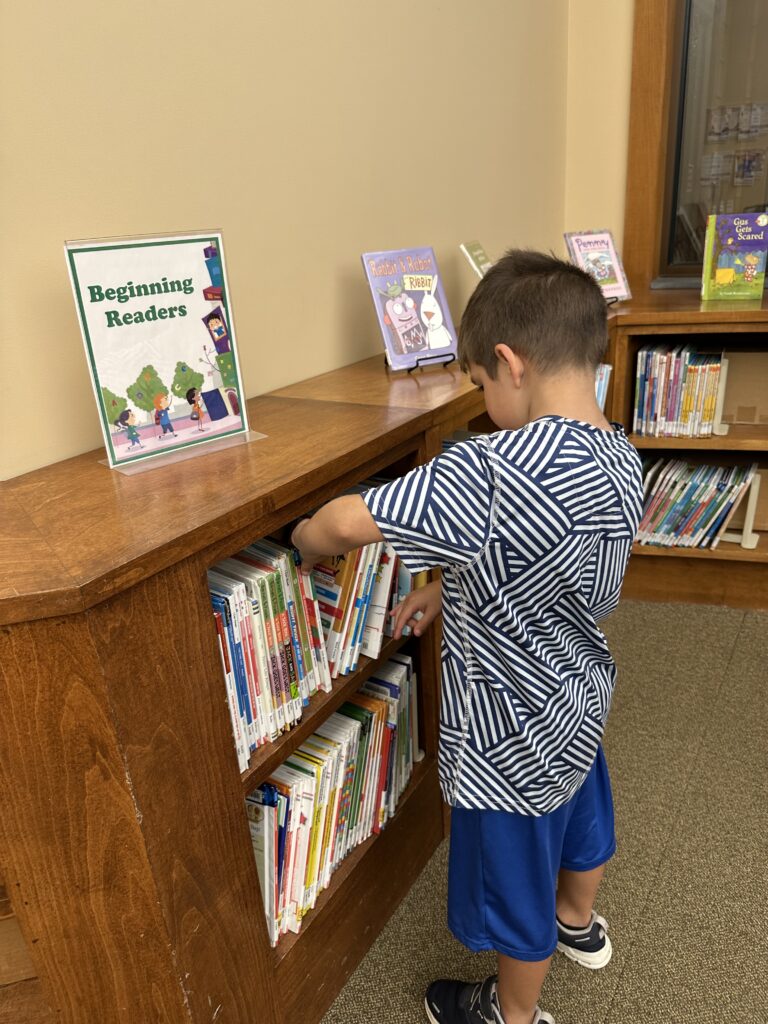
JD’s almost ten now, and he’s earned a little more freedom. He knows the areas he likes, so I let him browse on his own—but we have a “stay where I can find you” rule. It gives him some independence without me feeling like I’m chasing him across the building.
If your kids are at different stages, that divide-and-conquer approach can help—especially early on. I used to bring them one at a time and put books on hold for the other. That way no one felt left out, and I could actually be present instead of stretched thin.
If you don’t have the luxury of leaving one kiddo at home, this is where setting the stage beforehand really comes into play. You can even come up with a plan for one kid to flip through a book while you walk around with the other one and then switch. Over time, they’ll either get better at selecting books on their own—or at least get more comfortable sitting and keeping themselves occupied while you help their sibling. You can also consider picking up the books you put on hold first so they have something to browse while you finish grabbing a few more.
This is also one of the reasons we stick with our local children’s library instead of the bigger central branch. It’s smaller, easier to navigate, and just a little more forgiving when it comes to loud voices, wiggly bodies, or the occasional meltdown. I’m not constantly scanning a giant space—and I don’t feel like I’m being judged every time someone gets a little too excited.
What to Ask Kids During a Library Visit
About halfway through, I’ll peek at their stacks and ask:
- “How are we doing?”
- “Do you like what you’ve picked so far?”
- “Wanna swap anything out?”
That quick check-in has saved us from a lot of checkout meltdowns. It gives them a chance to reevaluate before we’re standing at the desk with a pile of books they’re suddenly not so sure about.
What to Do When the Library Visit Goes Sideways
Even with the best prep, some trips just go sideways.
They’re tired. Someone’s hungry. Somebody’s climbing on furniture. It happens.
And yes—I’ve followed through on the “If it gets too wild, we’ll leave without books” conversation. It’s never fun, but it made a big difference in how seriously they took the next visit.
This is also why I almost always keep a few books on hold—like I mentioned earlier. Even if we have to wrap things up early, we’re still leaving with something to read. It’s not the haul we might’ve hoped for, but it keeps the rhythm going—and avoids that “all this for nothing” feeling on the drive home.
How to Get Book Help from Librarians or Online Catalogs
If your kid is stuck or if you’re stuck, ask the librarian. You don’t have to know what you’re doing. That’s what they’re there for.
You can keep it super simple:
- “My kid loved Dog Man. Do you have anything like that?”
“Where can I find early readers?” - “Do you have any books about snakes/coding/art?”
If the librarian’s tied up or your kid’s feeling overwhelmed, most libraries also have public computers. You can search by title, author, or topic—whatever they’re into.
And if a book they wanted isn’t available that day? No sweat. Place it on hold before you leave. It softens the blow of walking out without something they had their heart set on—and keeps them looking forward to the next visit instead of sitting in that disappointment.
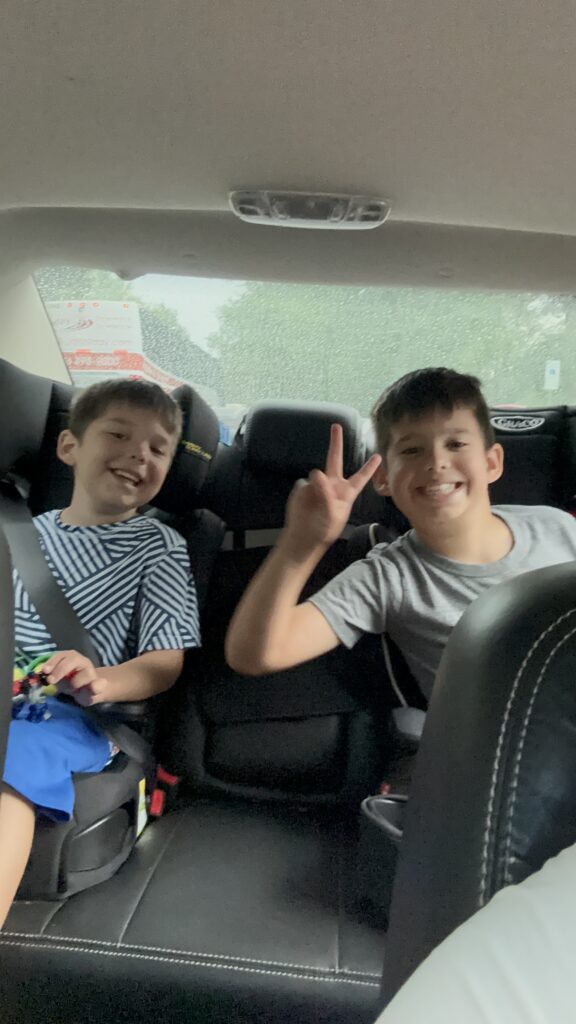
What to Do After a Library Visit with Kids
The visit doesn’t end when you walk out the door.
But that next step? doesn’t have to be overwhelming.
Here’s what it looks like for us:
- Library books live in one bin in the living room—easy to see, easy to grab. If they’re tucked away somewhere, they’re way more likely to get forgotten.
- No pressure to read everything. Some weeks we tear through our stack. Other weeks? It just sits there. That used to get to me, but now I remind myself—it’s not a waste. Having books on hand still matters.
- If a book goes back unread, I jot the title down for next time. Not this time. Maybe next.
- And if just one book clicks? That’s enough. One book that gets read, re-read, or sparks a conversation—that’s a win in my book.
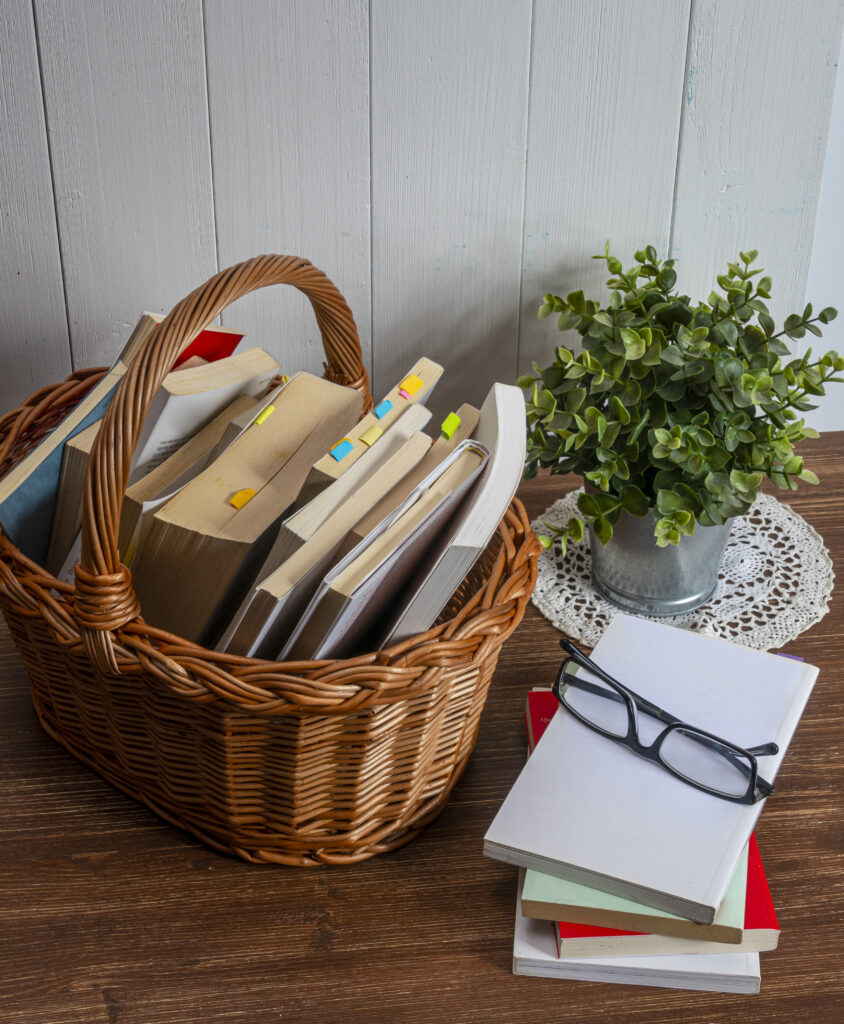
Actually, that’s what happened this past summer.
I was determined to get our reading rhythm back. I hadn’t taken the kids to the library in a while, so I rallied, loaded them into the car, and off we went.
It was a great visit. They were excited, picked out a giant stack—nearly 50 books between the two of them—and we narrowed it down to about 30.
I left thinking: nailed it.
And then? Life happened. Camp. Pool days. Travel prep. That glorious haul sat untouched in our living room. Most of the books went back unread.
I’ll be honest—I started spiraling:
- Why didn’t I time that visit better?
- Why did I let them check out so many?
- Why didn’t I follow through?
But when I zoomed out, I saw the trip differently:
- We made it there.
- We had fun.
- We found a few new favorites.
- And most importantly, Hunter started asking to read more on his own.
So no, it didn’t go how I imagined. But it still mattered.
That’s the shift I keep coming back to:
An “imperfect” visit can still be worth it.
It’s not about hitting some perfect standard, it’s about building momentum, tweaking what didn’t work and trying again. Every visit is a learning experience to figure out what works for your family, in this season.
Why Imperfect Library Visits Still Help Kids Love Reading
Some visits will be smooth. Others might leave you wondering why you even tried.
But every trip teaches you something.
You’ll figure out what kind of prep actually helps. You’ll start to notice which books really spark their interest. And you’ll begin to see the library as a tool—not just another to-do.
Over time, those visits start to feel less chaotic and your reading rhythm flows more freely. Because when the library fits into your family’s rhythm, it doesn’t just support reading—it makes everything else feel a little easier.

Still feeling stuck—or want a little help getting that rhythm back? The Reset & Read Workshop Replay is still available. I walk you through how we reset reading at home, without rigid schedules or added pressure.
Ready to Build on Your Library Momentum
If your latest library trip felt a little chaotic—or your stack of books is already gathering dust—you’re not alone.
Sometimes the trickiest part isn’t getting to the library… it’s figuring out what to do with those books once you’re at home.
That’s where the Mini Reading Goal Planner comes in. This free tool helps your child set, track, and celebrate a reading goal that actually fits them—without turning reading into a chore.
Inside, you’ll find:
✅ A flexible 4-step framework to help your child choose one small, achievable reading goal
✅ Visual tracker ideas (including a printable 2-week spread) that keep goals clear and consistent—without the pressure
✅ Simple reflection prompts that open the door to conversation (not correction)
✅ Creative celebration ideas to help kids feel proud of their progress
We used this exact planner after a rocky stretch in our own reading rhythm—and it helped Hunter rediscover his confidence with just one library book. That tiny win made a big difference.
If you’re ready to keep the spark going and make the most of your library haul, this planner is a great first step.
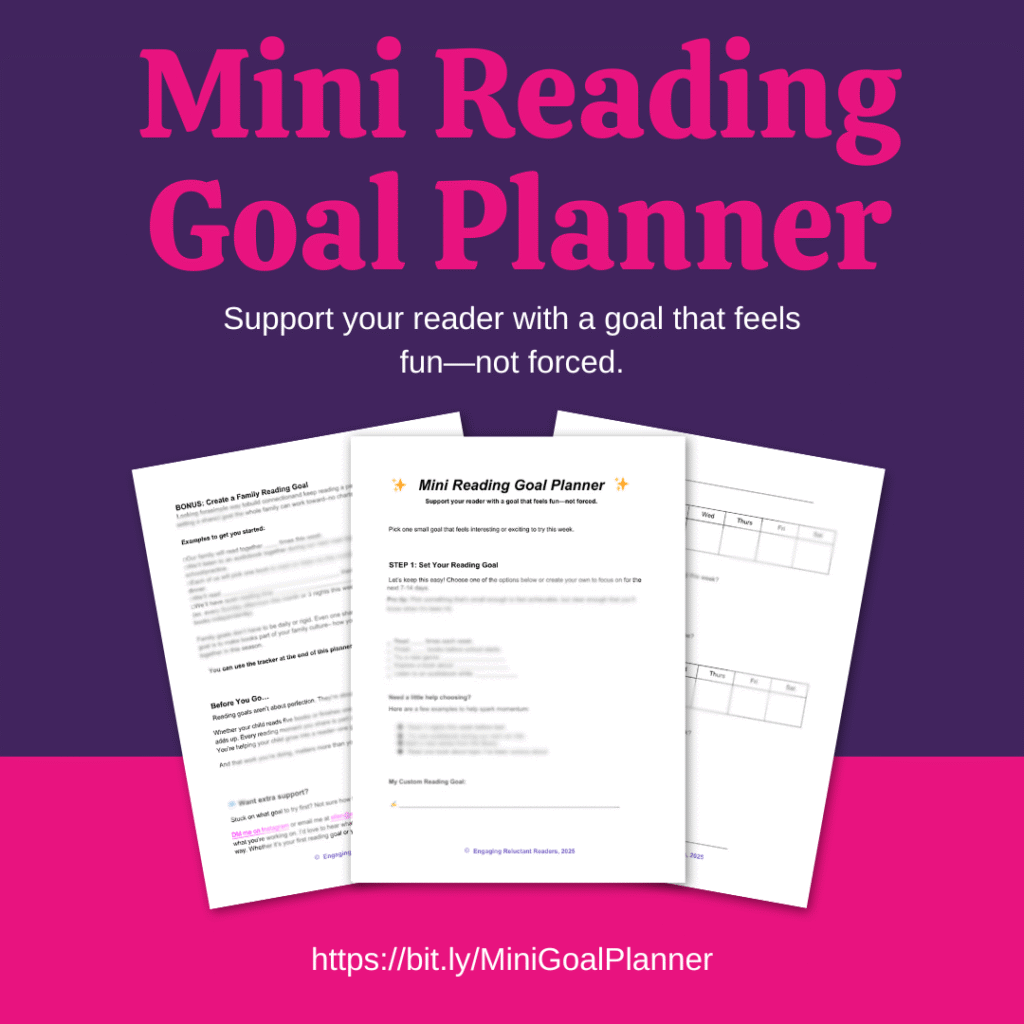
Suggested Resources to Keep Your Reading Rhythm Going
- Reset & Read Workshop Replay — Need help rebuilding your family’s reading rhythm? This workshop walks you through the exact steps I use at home to make reading feel fun, doable, and part of real life.
- Your Local Library’s Online Catalog — Place holds ahead of time, check availability, and save titles for your next visit—it’s a game-changer.
- How to Help Your Child Set a Reading Goal (Using the Mini Reading Goal Planner) — A practical companion to your free planner—this post shows how to set one small, doable goal your child will actually want to reach.
- Raising Readers Without the Pressure: How to Build a Home Where Books Belong (Using the 5B’s) — If you’re trying to make reading part of everyday life, this post gives you a simple, flexible framework to follow.
- How to Match Kids with Books They’ll Love — Not every book will click—and that’s okay. This guide helps you find the kinds of books that do.
- Book Rotation Tips to Keep Things Fresh — Keep your shelves feeling new and exciting—without buying more books or overwhelming your kids.
FAQs
What if my child doesn’t want to go to the library?
Totally normal—especially for reluctant or struggling readers. You can still keep them in the loop by placing holds together online, so they know what you’re picking up for them. Sometimes, easing the pressure is the first step toward rebuilding interest.
How often should we go?
There’s no perfect schedule. Some families go weekly, others once or twice a month. Pay attention to your reading rhythm at home—if the stack is feeling stale or interest is dipping, that’s your cue to plan your next visit, and remember even an “imperfect” visit still counts.
What if we don’t read everything we check out?
That’s okay. The goal isn’t to finish every book—it’s to stay engaged with reading. If a few sit unread, you can jot down the titles and try again later. Sometimes it’s just a timing issue. And sometimes a book doesn’t land the way you thought it would, there’s no rule that says you have to finish a book even if they don’t enjoy it.
How do I help my child pick “just-right” books?
Try previewing a few books together and asking questions like:
- “Does this look like something you’d enjoy?”
- “Can you read most of the words on this page?”
- “Does the topic or style feel fun, silly, adventurous…?”
This helps them learn to choose for themselves over time.
For more help, check out How to Match Kids with Books They’ll Love.
What if my library trips always feel chaotic?
You’re not doing it wrong—it’s just a signal to adjust. Try prepping a little more before you go (use this post as a guide), bring one child at a time if you can, and be okay with calling it early if needed. It gets easier with practice—and a little patience.


